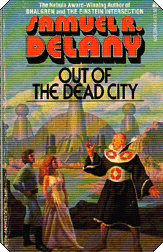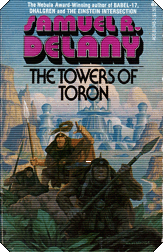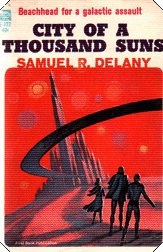The Fall of the Towers
by Samuel R. Delany
Reviewed by Galen Strickland
Posted February 28, 2022
Buy from Bookshop or Amazon. A purchase through our links may earn us a commission.
The Fall of the Towers trilogy has a long and varied history. The links above are for the current edition, but the image to the right is the copy I have, an ACE paperback from 1972. They had released it a couple of years before that with similar, but slightly altered cover art. The story began with "Captives of the Flame" in 1963, its first appearance being as one half of an ACE Double paperback. It was later edited, expanded, and given a new title, Out of the Dead City. The second part, The Towers of Toron (1964), was also part of an ACE Double, while City of a Thousand Suns (1965) was released on its own by ACE. I've found conflicting information about how much the three books were edited, but by my estimates all in my copy are definitely novels, but the first two may have started out as novellas. All were published in one volume in the UK in 1966 (*see NOTE below), and the US omnibus is supposed to be those same edits. While I don't know that for a fact, certain spellings (colour, rumour, etc.) seem to indicate they just copied the UK edition. There have been many other editions, foreign and domestic, but I don't know if the one linked above contains any further revisions. Earlier this month I re-read "Captives" via download from Project Gutenberg, so I know some passages from the first version that refer back to his first published story, The Jewels of Aptor, were excised for Dead City, while at least one other connection remained. I think the images below are the first US paperbacks of the individual titles, which I thought had been released before the collection, but that apparently only applies to the last one.
*NOTE: Something I find weird, Delany's introduction mentions the '66 UK edition, but I can't find reference to that at Wikipedia, FantasticFiction, or ISFDb; all say the first omnibus was in 1970. Googling "Fall of the Towers 1966 UK edition" came up with a used copy at amazon.co.uk, but it is apparently the same as mine as indicated by the image and text description. Why can I not find an image of a true UK edition?
 |
The connection to his first story that remains concerns an historical event known as the "Great Fire." Easy to assume that refers to a nuclear holocaust. In Aptor it was implied to have taken place about a thousand years before, but it's just five hundred years in Dead City. It may or may not mean Delany was saying they shared the same event, maybe only a similar one. On this reading I thought of a possible thematic connection to another Delany title, which I'll get to later. The dead city of the title is Telphar, abandoned after a radiation barrier appeared, cutting it off from other parts of the Toromon Empire, but that had happened more recently, not a result of the "Great Fire." The capital city of the empire is Toron, on an island separate from a mainland area that is also part of the empire. Some descriptions are vague and confusing, but I believe Telphar is on the mainland, or perhaps another island. This is supposedly Earth, but there are no descriptions that would give clues as to where on the globe the events are taking place. There are many disjointed scenes that follow several characters, which continues in the other books, and it's hard to identify any of them as the main protagonist. One that makes it through the whole series is the first to be introduced, Jon Koshar, who had been convicted of murder (although technically it was manslaughter), and sentenced to work in a tetron mine. Tetron is a fictional mineral used for energy production. Jon's father was a wealthy merchant who had developed aquarium and hydroponic farming to compete with farmers and the fishing villages on the coast. His sister, Clea, is a brilliant mathematician and engineer, who is duped into aiding the empire's war efforts.
"We have an enemy beyond the barrier!" is their war cry, but no one has any evidence for the identity of the enemy. When Jon escapes from the penal mines he is aided by a mysterious entity, and in so doing enters the dead city of Telphar. That entity, which he hears but cannot see, is possibly an alien. It alters his physical structure in such a way that he is not affected (or maybe just less affected) by the radiation. That alteration also causes another effect; in bright light he appears normal, but in dim light he is virtually invisible. When he returns to Toron he uses that to infiltrate the royal palace, and while doing so he is also talking to that mysterious someone who is only in his head. He later meets others who also seem to be talking to an unseen presence, but it's not clear if it's the same as the one he is communicating with. The one that talks to Jon warns him about the "Lord of the Flames," another entity that is possibly from a different dimension. Whoever or whatever they may be, they are supposedly the one that created the radiation barrier. Jon's alien describes themselves as a Three-Lobed being, meaning they can telepathically connect to three others at the same time. Another who may be communicating with the same entity as Jon is the Duchess of Petra, cousin to King Uske. Jon later suspects an inn-keeper to be the third, but Geryn is just someone who talks to himself. It's actually Arkor, a giant forest guard who is also at the inn, merely using Geryn to organize a special mission he is coordinating with the Duchess. They plan to kidnap Let, the younger brother of the king, and spirit him out of Toron and shelter him in the forests of the mainland. They know a war is coming, and they want Let to be safe throughout that conflict, so that he can come back and become the new king.
Other characters include Rara, a street peddler, Alter, her niece, and Tel, a young fisherman running away from his abusive father. Alter is an acrobat who occasionally works with a traveling circus. She teaches Tel some of her tricks and moves, which she also employs for the kidnapping. Jon meets most of them, and ends up helping Arkor take Let to the forest. There is a remarkable amount of detail in both plot and character for such a short book, but of course being just the first part of the story, the reader is left with many questions as to the motives of most of the actors. I was disappointed with how scenes kept shifting just as things were getting interesting, and I had a hard time deciding which characters were the most important. Others are introduced in the subsequent books, and not all I've already identified survive to the end. Some of the deaths are similar to those in real life, sudden and unexpected, and they didn't necessarily propel the plot. At times I got the feeling Delany did away with some of them simply because he couldn't figure out what to do with them. There are also scenes involving the Three-Lobed being and things he tells and shows Jon and the others, a lot of which could be dismissed as induced hallucinations, but if they are real, they take place either on another planet, or in the depths of space, with the humans visualizing themselves as various other extra-terrestrial species. I've said very little about Clea so far, but she was my favorite for most of the trilogy, and even though some of her actions were suspect, later explanations exonerated her. She determined that the radiation barrier was artificially produced, probably using just three generators, maybe only one, and Jon, Arkor, and the Duchess were successful in disabling them. With that "conclusion," the beginning of the second book at first seems disconnected from that.
 |
It's three years later, and Toromon's war against the enemy beyond the barrier is in full force. It seemed that the Lord of the Flames had been defeated, if he had actually existed at all, so who is the enemy? Clea has gone into hiding, changing her name simply by reversing the spelling of Koshar, which shouldn't have worked since her father had another business that used that spelling. She feels guilt about something, but her memory seems to be blocked, or she is actively blocking it herself, so what she had to feel guilty about remains vague for most of the book. She becomes friends with Alter, who convinces her to join a traveling circus as their accountant. Alter and Tel had become close, but now they are separated as he trains in the army. He is drilled on the maintenance of equipment, the purpose for which he is never told, even when deployed beyond the barrier.
One thing I have not mentioned yet is that at least in the forest regions, which are nearer the radiation barrier, different mutations have occurred. There are at least three distinct groups of people, "normal" humans, the giant guards like Arkor, most of whom are telepathic, and neanderthal-like sub-humans, who have undergone devolution, or maybe it's a re-evolution. The normals are wary of the telepaths, and when that ability is spotted the telepaths are marked with three scars on their left cheek. The war troops are gathered from all areas, civilians from Toron, regular forest folk, guards, and neanderthals. Another group of Toron citizens evade conscription, the malis, short for malcontents. Most are gang members, thieves, drug runners, extortionists. The confusion about the war efforts makes sense with later revelations, part of which connects to Clea's memory loss, but she's not the only one who had been deliberately kept in the dark. Her brilliant mind eventually breaks through the blocks and she figures out what the war is all about. Her guilt was due to her being part of the cover-up from the beginning. No, I will not explain that.
 |
City of a Thousand Suns opens on one of the planets Jon, Arkor, and Petra had been psychically projected to before, and it's easy to assume the city on that planet is the one from the title of this book. No, that comes later, and it's on Earth. The Three-Lobed being has assembled multiple other species to tell them of the progress against the Lord of the Flames, who had only been thwarted at the end of the first book, not killed or definitively defeated. They are expecting Jon and the others to appear with the information needed to make the Lord's defeat permanent. They are supposed to bring Clea's treatise on a Unified Field Theory, a historian's book, as well as poems written by the mali Vol Nonik. Clea and the others who have those works are unaware of what they are expected to do, so the fact they do come together at the end is a series of serendipitous events.
Several other deaths occur throughout, a couple of which really irritated me, since it seemed to imply they weren't important, and that what they had previously been put through was for naught. While the Three-Lobed being could interact with and direct three different people at a time (and in at least one instance more than that through the telepath Arkor), the Lord of the Flames was limited to influencing just one at a time. Some of their actions through their puppets caused some of the deaths, in other instances the target was able to subvert their fate and escape. Another frustration came when it seemed Delany abandoned certain rules previously established, and the fate of several main characters just fade away, never to be resolved. The City of a Thousand Suns turns out to be a fairly new one, still being built on the shores of a lake on the mainland opposite Toron. A lot of different people come together for that project, the most surprising being some malis, although different from the rest. They were malcontent about the other malis, true revolutionaries who wanted to build for the future, rather than the destruction that delighted the gangs. Looking toward the future, they envisioned space travel, eventually reaching up to a thousand different worlds. Again, no resolution to that thread, but their optimism is encouraging.
Back to something I said earlier. Seeing as how the Three-Lobed being was apparently from some distant part of the galaxy, maybe even a different galaxy, and the Lord of the Flames might have been from an alternate universe, I was reminded of Delany's Einstein Intersection, which is about the aftermath of a parallel universe colliding with our own. Delany was still finding his way with these early books. They're full of metaphor and allegory, and some profound thoughts, but he had yet to develop the talent he would later reveal in his more mature work. The story rambles too much, there are too many detours and unresolved issues, and as short as the whole trilogy is, it could have used tighter editing. Not a total disappointment, but I can't recommend for most readers.
We would appreciate your support for this site with your purchases from Amazon.com, Bookshop.org, and ReAnimusPress.